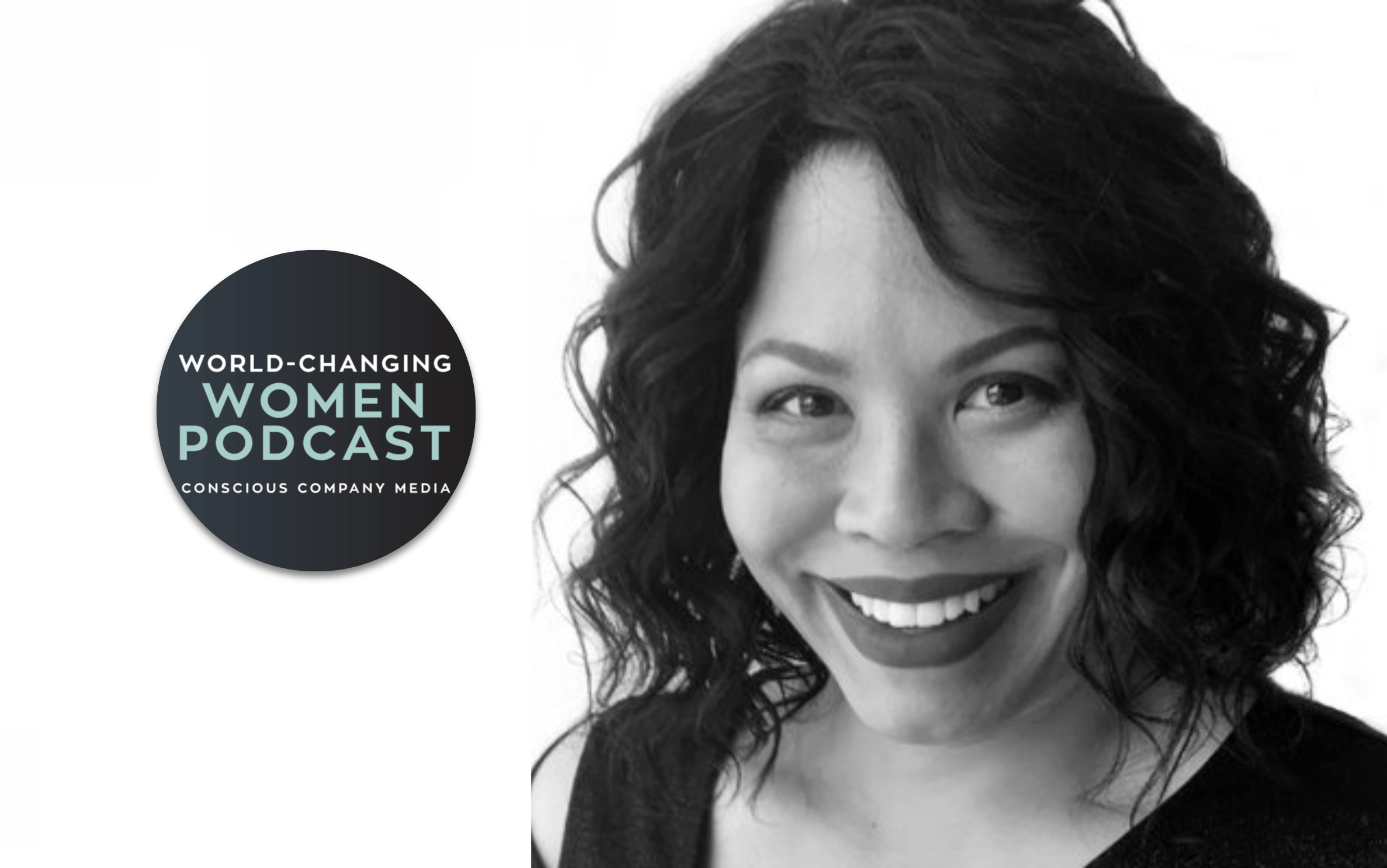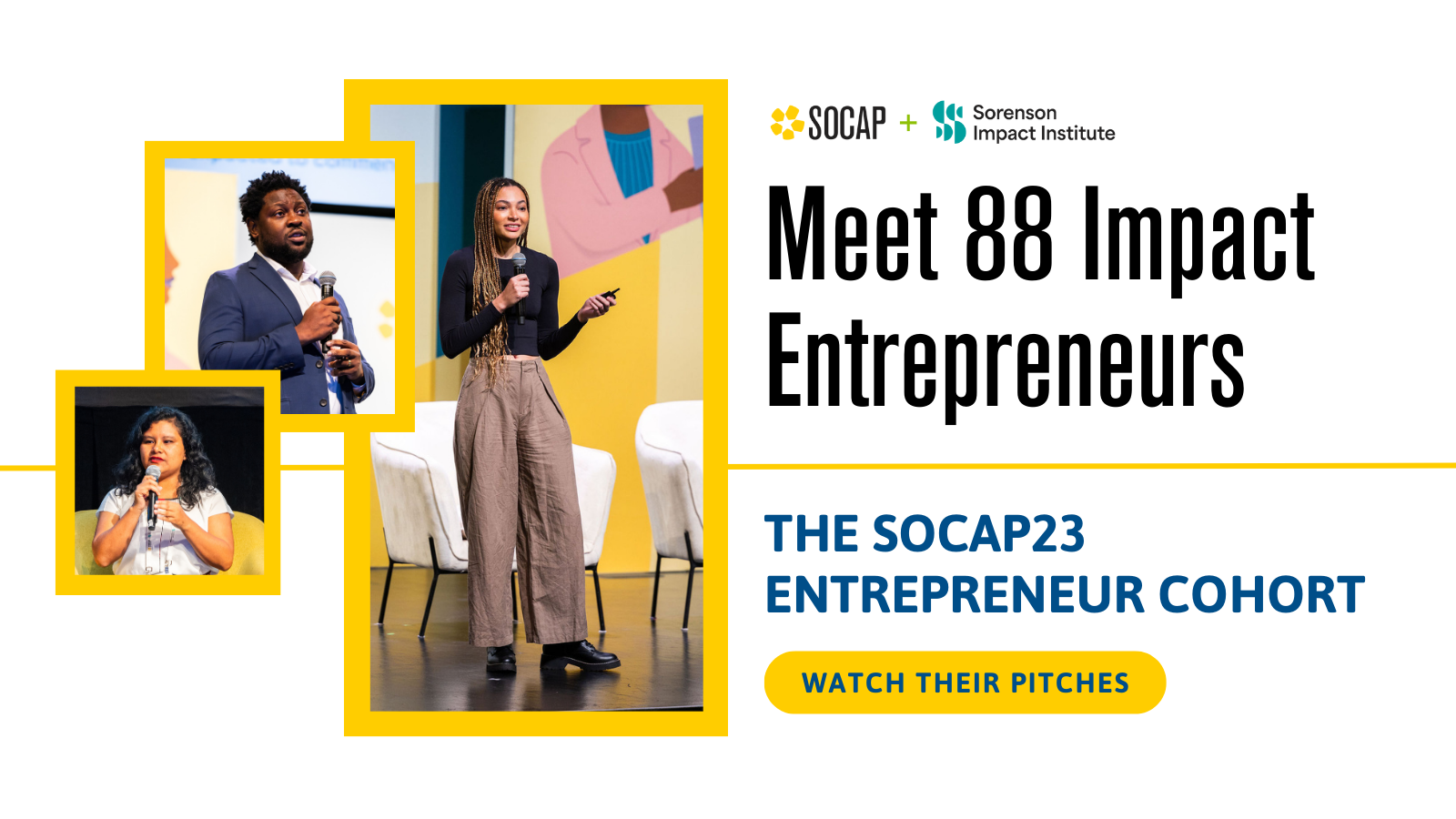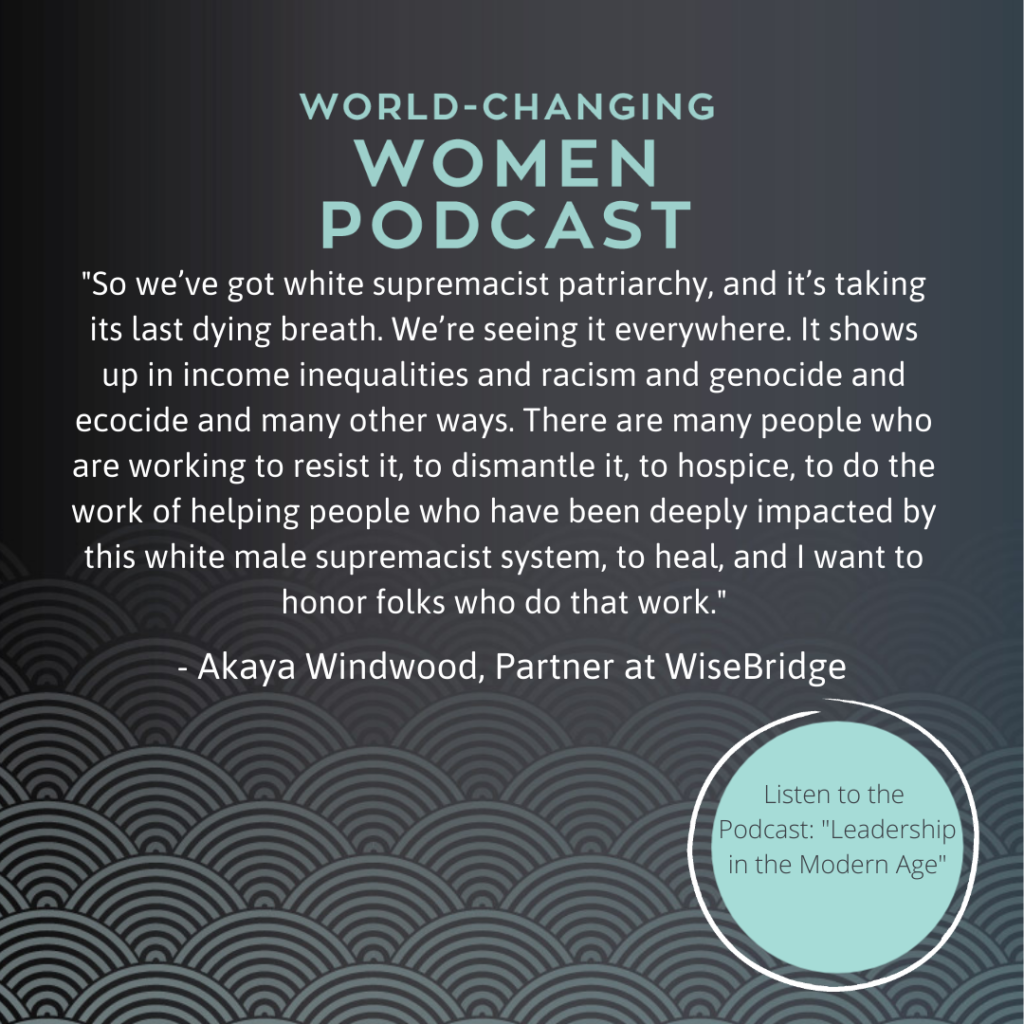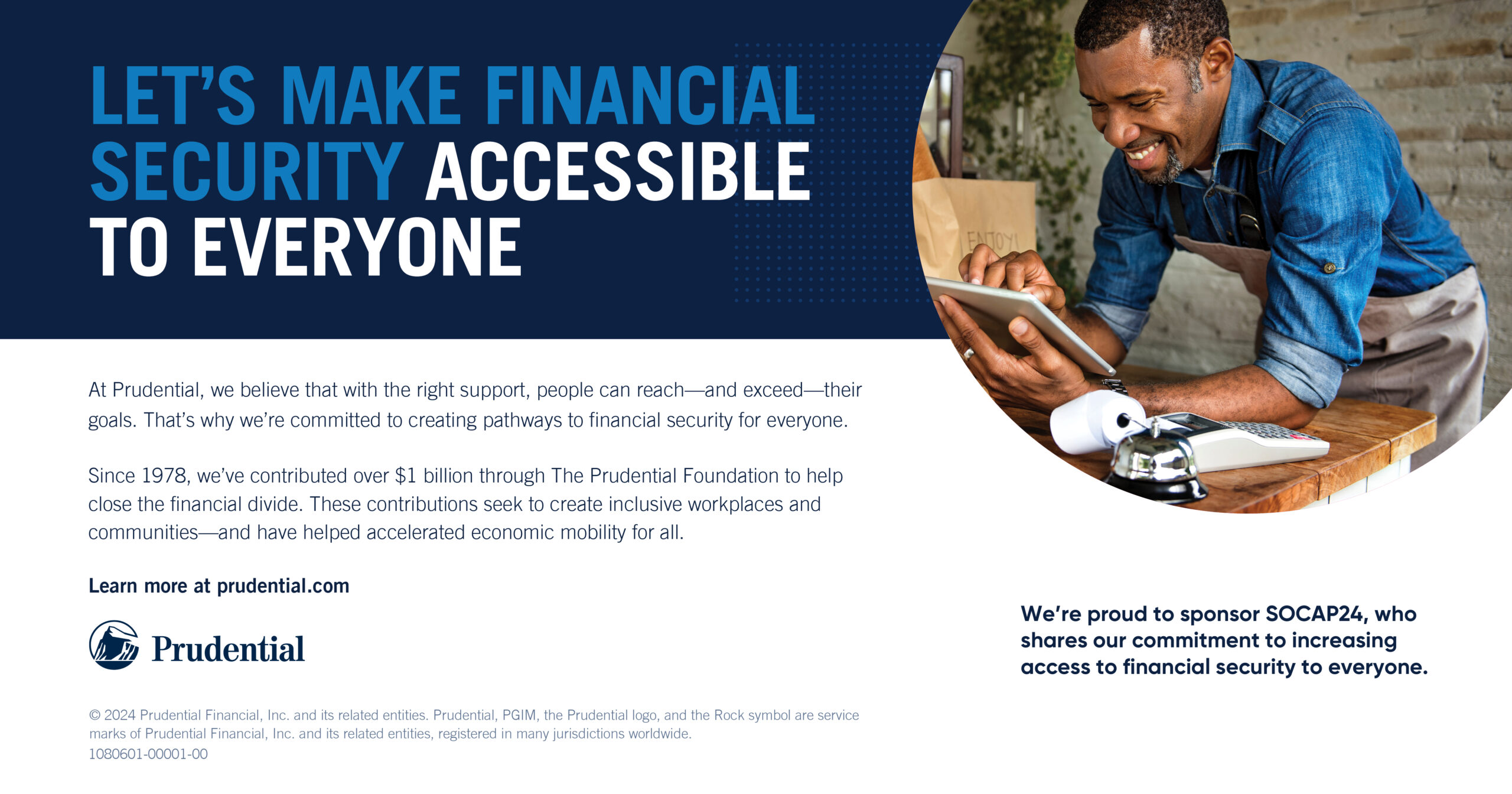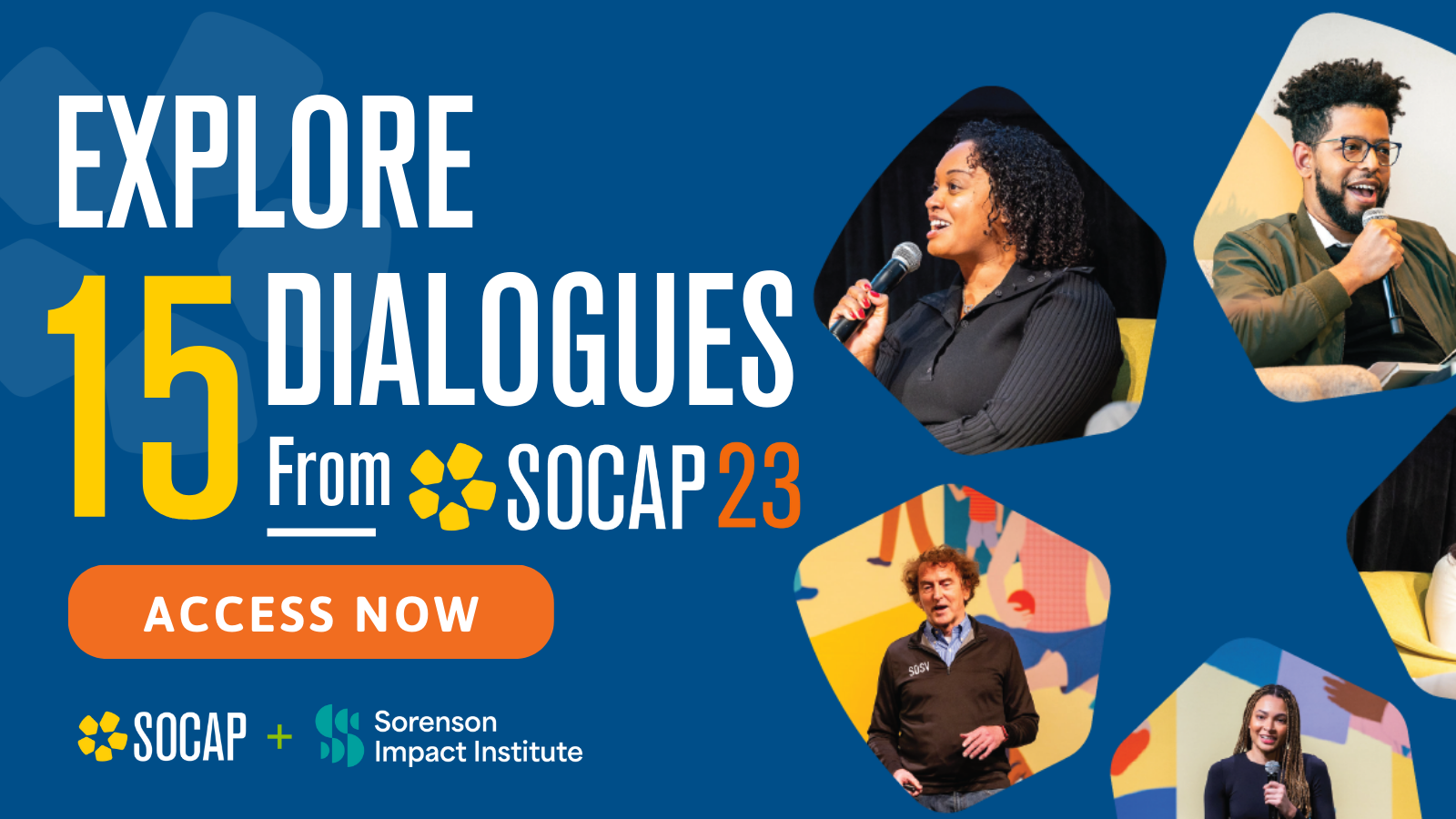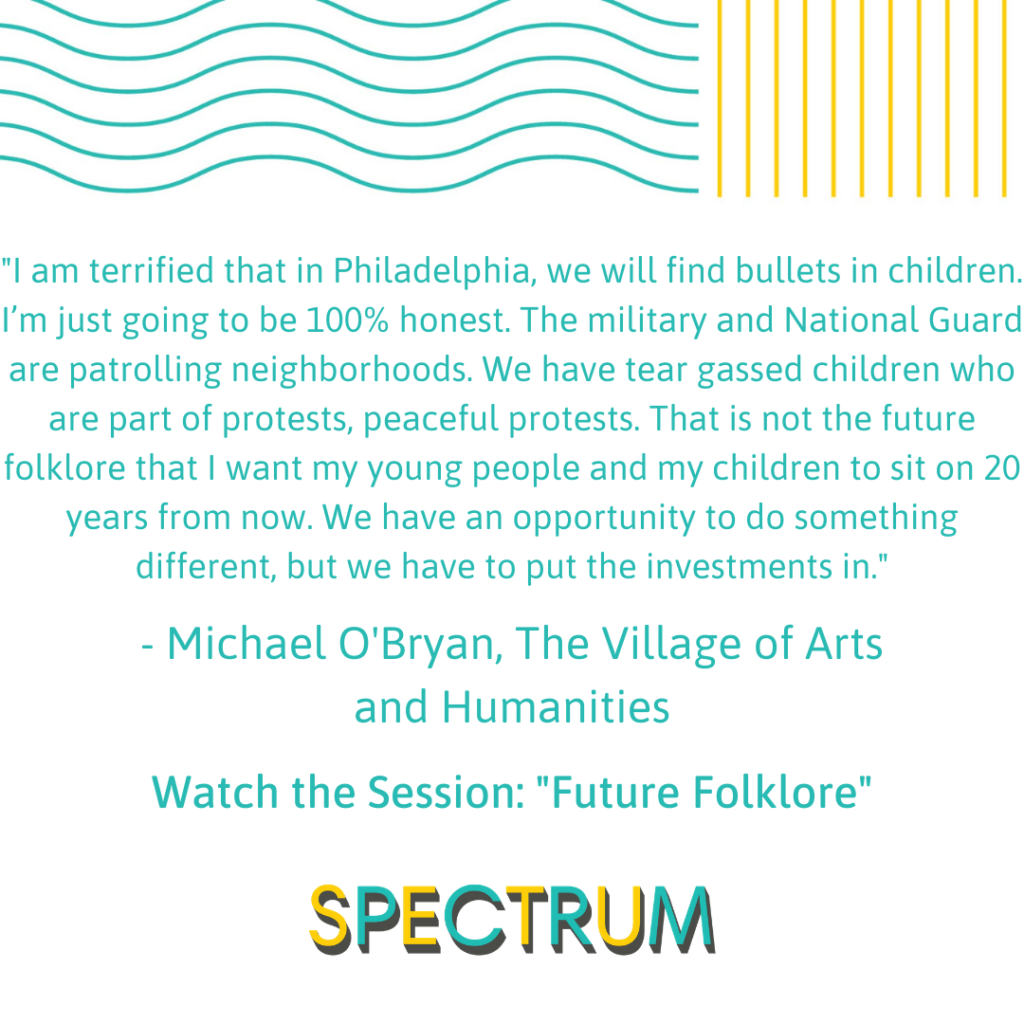Cheryl Contee Shares Her Tips for Social Entrepreneurs, Business Leaders in this World-Changing Women Podcast
Conversations around justice and equity in the economy have become increasingly prominent, especially given the current movement for racial justice. True stakeholder capitalism that creates a more just economic system for all must make these values cornerstones of the economy. The responsibility to make that systems change falls on all of us: business leaders, entrepreneurs, investors, and consumers.
Currently, leaders in the impact economy are facilitating the transition to stakeholder capitalism by sharing and exemplifying beneficial business practices. These practices range from strategic investments that aid communities which are typically exploited in the economy to writing equitable policies into a business’s founding documents and policies. And to maximize the nation’s ability to innovate and create, members of the economy must begin to embrace communities of color.
“It’s demographics. This is happening right now,” said Cheryl Contee, CEO and Founder of the mission-driven digital agency, Do Big Things. “There is already a majority minority in terms of the children of America. So that America is coming. That means that we have to have an America that is willing to embrace genius and innovation no matter what package it comes in because that is how we continue to be a strong and prosperous nation.”
In this World-Changing Women Podcast, Cheryl shares her tips for social entrepreneurs and business leaders seeking to elevate their impact and aid this economic transformation. She highlights real examples from her own experiences that show how systemic racism impacts the economic opportunities available to communities and people of color.
Listen to the podcast or read the full transcript below.
Show Notes:
The Way We’re Working Isn’t Working by Tony Schwartz and Jean Gomes
HBR Article: Advice on Launching a Tech Startup When You’re Not a White Man by Cheryl Contee
Nina Bernardin: Hi, everyone, and welcome back to the World-Changing Women Podcast. I’m your host, Nina Bernardin. On this podcast, you’ll hear from mission-driven women entrepreneurs, thought leaders, and change makers who are transforming business as usual. These pioneering women are using the power of business to move the needle on the social issues that we all care about, like gender equity, racial equity, climate change, and so many more.
Cheryl Contee: I was experiencing real bias. I mean, plain and simple, and I wasn’t prepared to stick around for more of it.
Nina Bernardin: I’m so excited to share this amazing and timely interview with Cheryl Contee. Cheryl is an author and serial tech entrepreneur. She co-founded and sold her first company, Attentive.ly, and is now the CEO and founder of the mission-driven digital agency Do Big Things. On top of that, Cheryl is the author of “Mechanical Bull: How You Can Achieve Startup Success,” and she’s an award-winning political blogger. Seriously, Cheryl is nonstop.
We recorded this conversation on June 3rd in the midst of national protests of the murder of George Floyd. In our conversation, we talk about systemic racism in business and building diverse and equitable workplaces. This is World-Changing Women. Thank you for listening.
To get started here, can you tell us a bit about your founding story, your journey as an entrepreneur, and what mission drove you into the kind of business that you founded, sold, and founded again?
Cheryl Contee: Well, when you look at the businesses that I’ve founded, and yes, I have the sickness of being a serial entrepreneur. I have ideas, and I’ve been very, very fortunate to find partners who wanted to join me and team members who wanted to join me in those crazy ideas and in some cases to find investors who were down for supporting those crazy ideas.
But really at the heart of and when you look at all of those things, whether it’s Jack and Jill Politics, which was my political blog that focused on pop culture and politics from a Black bourgeoisie perspective. It was once a really popular blog. Whether it’s Fission Strategies and now Do Big Things, which are digital agencies that serve causes and campaigns that I founded, or Attentive.ly, which is the SaaS tech startup that became the first tech startup with a Black female founder on board, myself, to be acquired by a NASDAQ company, when you look at all of those endeavors, the ribbon that underpins them is service, right, is how can we be of service? How can we use technology and digital transformation, a trend that’s happening, to actually help create better outcomes for more people and support the people who are working on that every day?
So that’s really been my focus, and look, I think that one of the things that’s really exciting to me about Attentive.ly, which is a social marketing automation and social listening tool, is that it was a next economy, a new economy startup, a social impact startup that was acquired by a social impact corporation. It shows that the future is possible, and one of the things that we were keen to do, even though we were small, we were very visible in our space, in the nonprofit sector, because we were a female-led company and female tech-led startup with, of course, a minority founder, we wanted to show that you can invest in women, you can invest in Black women, and you can make money.
That is, I think, the biggest thing that’s really missing from some of these conversations. I live in Silicon Valley, and I’m sure that helped me to find investment, but we’re in this situation where people have great ideas for products, for services, for apps that can make a really big difference in people’s lives, and they’re not getting the investment they need to bring that to life. That ultimately means that we are hindered. We are slowed in creating that next generation economy that’s going to sustain our nation and our world.
Nina Bernardin: So I’m really curious about what your process was. How was your personal journey of building both companies, what was that experience like for you personally?
Cheryl Contee: Oh, absolutely terrifying. It was terrifying. It’s terrifying to start your own business. But to a certain extent, the first business, which is Fission Strategy, is a digital agency working with causes and campaigns. That was started because I was passed over for promotion. I had been recruited out to San Francisco to work for a pretty big multinational PR company, and I drew up a plan for, “Look, I need to hire a couple of people. Here’s how. But if we do the things that I’m recommending, including hiring some more people — I’m working like 18 hours a day — I think we can bring in a million dollars of revenue.” I was already bringing in hundreds of thousand dollars of revenue, and I was passed over for a promotion that had been promised in my offer letter.
In that moment, it was like someone was like, “Boop, you were here, and you need to be here.” I said, “If you’re not going to promote me, I’m going to resign,” because I added up in my head, “If I can bring in a fraction, a fraction of the amount of money that I have brought in for this organization just for me, I might be okay.” I was willing to make that bet. I get it. I mean, I wasn’t a parent then. I get, especially if you’re a parent, that that is an even more terrifying direction to take. But I was experiencing real bias. I mean, plain and simple, and I wasn’t prepared to stick around for more of it. I was willing to stand up for myself.
So literally, I ended up leaving that day, and I put out a tweet. I mean, the power of a network. I put out a tweet, and I said, “Hey, I suddenly seem to find myself available. Who wants to work with me?” I actually got a lot of incoming. I was relieved, but also pleasantly surprised that people wanted to work with me. One of the things that came in was the now-husband of my business partner, then Roz Lemieux, who said, “Hey, my girlfriend is also doing kind of an indie consulting thing. I think that you two would maybe have a really interesting collaboration.” We worked on a project together, and it was magical. We very much completed each other. We built from there.
But from the start, I mean, we had very little startup capital. I mean, I had about $10,000 in the bank, she had about $10,000, and I was like, “Look, if we can’t get some clients in this month, I’m going to have to go out and find a job.” But fortunately, we were able to do that. We were able to go from two people to 10 within a year. We made that million dollars in revenue within that year, that first year. What was even more rewarding about that was that I was doing the work that meant the most to me. It’s not that I didn’t enjoy helping to sell laptops or soap or football tickets, but being able to work with and provide services to nonprofits, tech services to nonprofits and consulting to nonprofits and causes that were meaningful, that remain meaningful, that just brought a lot of fulfillment to my daily work.
So then from there, Fission, one of the trends that we were seeing in our space was that people were launching startups, and they weren’t content with, “These are the tools that we have.” It was very much a time of innovation and saying, “Look, if the tools don’t exist that we need, we can build these tools.” That was basically what we saw in the corporate marketing world, some of the influencer engagement and marketing automation tools that were out there. Yet they were at a price point that was beyond what most nonprofits could stomach, and they weren’t really tailored for the kinds of activities that nonprofits are engaging in. So we decided to just build that.
Now, at the time, I didn’t know that 0.006%, so basically statistically $0 of seed capital or venture capital, went to Black female founders. Didn’t know that, fortunately, but found out real quick that even though I had run a fairly successful political blog, that I had been on CNN, in the New York Times, and even though we had built a company with multi-millions of dollars of revenue, that I was going to have a hard time. I was really the lead fundraiser for that first round.
Yeah, it was really tough to have people even just take my calls. Then when I would get in to do, say, a demo or talk to a potential investor, literally I sat across from a person who I gave him a demo of the software and talked about the market opportunity, et cetera. This was a fund that’s whole raison d’etre was to find people like me and invest in non-traditional founders. Okay? He looked at me, and he said, “Well, this is a really important tool. I definitely can see how important it would be, but I’m not sure if you are the person who could actually take this to market.”
Nina Bernardin: Wow.
Cheryl Contee: Yeah. I mean, people said stuff to my face, Nina, during the startup process that in some ways, I think I’m still emotionally processing. I mean, writing my book “Mechanical Bull: How You Can Achieve Startup Success” was part of that process, both catharsis, but, I mean, I really wrote the book that I wished that I had had when we started out, in part because after we had sold Attentive.ly and I’d been doing some public speaking, this friend sat me down and said, “Look, Cheryl, literally more people have been to the moon than have done what you have done, and you have an obligation to help other people reach that success with their businesses.”
I’ll tell you, it’s not easy. I mean, I had a long conversation with the leader of an angel fund that focuses on women and female startup investments. She said, “Look, I’ve worked really hard and our team has worked really hard to weed out as much of the bias in our process as possible. Because we really wanted to fund Black and Brown women, wanting to make sure that we were filling out that part of our portfolio. We did it. We were able to do it until it got to people signing checks. It came to people signing checks. That was the place where we had the biggest problem.” She said, “It takes us about an average of seven contacts to get a white female funded. It takes us 50, five-zero, 50, 50 contacts to get a Black woman funded, even all things being equal, like they’ve got a successful business, they’ve got a good business plan, solid team, et cetera.” 50. That’s what I was up against.
Nina Bernardin: That’s insane.
Cheryl Contee: Because I’ve been hearing people being like, “Well, what is systemic racism? What is institutional racism?” That. That is institutional racism. For white guys, it’s probably two. I don’t know the actual numbers. It’s probably two or three, right? So white women, okay, I get it. I feel your pain. I’m here for you. But know that as a Black woman, it would have been what? I mean I’d have to do the math. It would be seven times harder. Okay? Seven times harder to do the same thing that you are trying to do. Okay? Let me tell you this. Can I tell you a story? Can I tell you a quick story?
Nina Bernardin: Yeah, please.
Cheryl Contee: People have probably heard of the real McCoy, right? The real McCoy, that phrase is actually about a real person, Elijah McCoy, who invented this railway part. I’m not a rail technician, so forgive me, but invented this technology that helped locomotives use less fuel and go further faster, a huge deal in the late 1800s. Yet because he was Black, it took him 20 years to get the funding that he needed. Yet here was this transformational product that was so important, and there were so many knockoffs that people would say, “Well, I need the real McCoy.” Okay? “I need the technology, because this is a piece of crap and not very high-quality.”
Now, imagine how much further we would be as a country if his groundbreaking technology had just been funded and fully funded faster, right? I mean, that’s what we’re up against. That is what is holding our nation back because we’re not being willing to draw from the genius of our people, wherever it is, whatever package it comes in. That is the future, folks. It’s demographics. This is happening right now. There is already a majority minority in terms of the children of America. So that America is coming. That means that we have to have an America that is willing to embrace genius and innovation no matter what package it comes in because that is how we continue to be a strong and prosperous nation.
Nina Bernardin: Wow. I can’t believe I’ve never known that story about the real McCoy.
Cheryl Contee: Dude, it’s pretty messed up. Seriously, yeah. So I like to tell that story. And look, I mentioned earlier the 1968 Kerner Commission Report. So in 1968, Lyndon B. Johnson, the then president, wanted to understand the unrest that was roiling in American cities, particularly in Black neighborhoods. The Kerner Commission summarized what they thought was going on. I’m going to read that excerpt to you right now, because I think it’s important for the moment that we’re living in in general in 2020, which is, “Bad policing practices, a flawed justice system, unscrupulous consumer credit practices, poor or inadequate housing, high unemployment, voter suppression, and other culturally embedded forms of racial discrimination all converged to propel violent upheaval on the streets of African American neighborhoods in American cities North and South, East and West.”
It’s not in African American neighborhoods anymore. Okay? It’s in your city right now, and it will be in your city until things start to change. One thing that people don’t know about 1968 was that there was a deadly flu pandemic going on. We don’t talk much about it, because there was a whole bunch of other stuff going on in 1968.
Nina Bernardin: Really?
Cheryl Contee: Yeah. I mean, it wasn’t as deadly, obviously, it wasn’t like the coronavirus. It was a different situation, but it was still bad. It was still a pretty bad flu pandemic with two waves, the second worse than the first. You’re business people. You need to plan for that. Okay? You need to plan that, just like in 1918, just like in 1968, that the next wave of this will be much worse. Therefore the inequities that were exposed then that people are re-experiencing now and that have been shown to us in bald relief are going to result in people asking a lot of questions and demanding better systems and better policies.
Nina Bernardin: I mean, it’s burning to ask, what do you tell yourself when you’ve experienced that kind of overt racism and when you learn these kinds of statistics? I hope that that’s an appropriate question to ask.
Cheryl Contee: Sure, because you haven’t experienced that, because it’s like, “Yeah. What is that like to just have to deal with systemic racism that is impacting your daily life?” Here’s the thing about racism and sexism, folks, is that it is illogical. It is irrational. It distorts normal processes. It’s not just a moral thing. Okay? It just absolutely warps what would be just a normal person trying to go through their day. Right? So all of a sudden, you think that you’re just having a normal day, and all of a sudden, it’s like, “Oh, racism. Okay. Well, now I’ve got to deal with that in addition to getting a new toaster. I’m trying to get a new toaster, and this shop owner is following me around the store, because they’re worried I’m going to shoplift. I’m just here to get a toaster.” Okay?
Imagine that. Imagine that’s your lived reality, but you’re just like, “I’m trying to give you business, and somehow this became some other thing.” So in some ways, that’s what it’s like, where you’re like, “I’m doing my thing.” Then all of a sudden, there’s some kind of weird moment where you have to recalibrate, basically. You have to recalculate and be like, “Oh.”
So in the case of trying to get investment for Attentive.ly, I shifted gears. I was just like, “Okay. If someone is clearly not responding or I’m getting some kind of weird signal distortion, I’m just onto the next. I can’t spend a lot of emotional time processing. I don’t want to talk to you. I’m not going to make you feel better. I’m moving on.” So that’s how I got to, apparently, that 50 people, until it was just like, “I’m just going to keep going. I’m just going to keep working through, and I have confidence.”
I would say if you are an entrepreneur or you are a leader within a company, I mean, that’s what it takes. It takes to a certain extent a lot of confidence in yourself and in things turning eventually. It just means that you have to keep showing up, and that’s one thing to know about Black people, we will just keep showing up. That’s who we are. We’re not going away. Can’t get rid of us, so, given that you know we’re going to keep coming, you might as well just invest in us. Then we can all make money together, or hire us. Hire us beyond the junior level. Hire us to be leaders and seniors and therefore help you make better decisions that then mean you don’t have to board up your store because of the racism and people’s reaction to the racism.
Nina Bernardin: I’m looking up Do Big Things, your current company. That’s part of your strategic advantage, is that you have, I believe I read, 70% people of color on your team.
Cheryl Contee: We are 70% women. We are 50% people of color. Yeah, part of it was strategic, right? Given the causes and campaigns that we work on, what we tell our clients is that we’re better able to use the new narrative and new tech that’s needed in this new era today because we are those voices. We are immigrants, so we can talk about immigration. We are people of color, so we can talk about racial and ethnic discrimination. We are people who have experienced gun violence. One of our clients is Everytown for Gun Safety, and so we can bring a very different lens. We are mothers, so that means that we respond to issues related to women in a different way, whether it’s climate change or what have you.
So we believe that is a strategic advantage in that we understand the audiences that our clients are trying to reach, because we are those audiences, right? We are those people. We come from those communities. But also, yeah, unashamedly, we want to provide a safe place for female and technologists who happen to be people of color who want to work on the next economy. We want to provide a home for those people who want to do that. We’re diverse in a lot of ways, not just gender, not just ethnicity, but also geographically. We have people in the Midwest. We have people in the South, on the East Coast, on the West Coast. We have people who their families have been in this country for centuries. We have people who are first generation immigrants. We have designers. In terms of what people do, we have designers. We have developers. We have writers. We have people who also bring a lot of diversity just in how they see the world and the talents that they bring to the table.
So that’s something that we’re passionate about and that we believe just makes sense. Any broker, right, those of you who have brokers or maybe you handle your own investments, anything that will tell you diversity brings you strength. I know this is a sophisticated audience. I know you guys get this. But just so you have talking points to give to other people, all of the studies show that the more diversity that you have in your organization, particularly in its leadership, means more profits, better productivity, better brand support. So if you want to make money, if you want to make money out there, do you like money? If you want to make money, a good way to make money is to really invest in diversity in all of its forms in your team.
Nina Bernardin: It’s beautiful that you experienced this and you’ve now created a different paradigm for your company. Did you ever come up to those same hurdles that you hear people saying, like, “Oh, I couldn’t find anybody,” or “I’m just trying to find the most qualified person for my role,” some of those other excuses for why people don’t have diverse teams? Did you come up against some of those hurdles yourself, and how did you navigate those?
Cheryl Contee: No. No. No. it’s actually just not that hard.
Nina Bernardin: Sorry.
Cheryl Contee: Not to interrupt you, but it’s like, “No.” It’s not that hard if you’re trying. What I will say, though, is that because I’m a person of color, it’s easier for me to, right, reach into communities. Part of the issue for a lot of white people, I could be misquoting, but that something like 70% of white people don’t have a Black friend or they don’t know someone personally who’s a person of color. That’s part of the problem that white people need to fix. Okay? It’s part of what’s going on, but white people need to work on white people. Okay? Part of that, if you’re a white person listening to this, examine your network and your colleagues, your friends, your family. If you don’t actually personally know a person of color, make that an agenda item. Okay? Your new goal is, “How do I build my network such that it is large enough that when I go looking for a diverse team, that it’s less hard for me?”
But bottom line is there are so many resources now. Okay? It’s not that hard. You can even just be very clear in your messaging, like, “We’re looking for a diverse team. We welcome minorities to apply. We welcome women to apply. We welcome immigrants to apply.” Throw open. Change the energy, and change that energy from, “We want the most qualified,” because the most qualified is often a code, I have found. Even if people don’t intend it, it’s code for implicit bias.
I will say I know it’s been an issue at times with internal staff, not our current staff, but sometimes you have people who even though they are well-educated on these issues, they still can’t turn off their own filters, where someone like me had to step in and say, “This person is qualified, and I think we’re going to hire them. I don’t understand what the issue here is, but we’re going to go ahead and hire them, because they’re qualified.”
So I think you have to actually be that person, because it’s not like people are going to go around saying the N word, right, or in some ways saying, “Oh, we don’t want immigrants,” or “We don’t want someone who has an accent or an inflection.” It may be an implicit thing that someone just has blinders on, or it may be just a subtle way in which they’re behaving where, “Wow. For some strange reason, the only people we’re interviewing are white people.” Be that person. Don’t assume that it’s okay. Don’t assume that people see their bias in action. Be the person who speaks up and says, “You know what? I would like to actually make sure we’re interviewing some people of color for this role or some women for this role. What do we need to do?”
Maybe you do have to work a little harder. Maybe you have to reach beyond your safe networks, right? But is it worth it? Again, I’m going to return to not just the moral imperative, but the economic imperative. Do you want to make more money? Okay? Because if you want to make more money, then you’re going to put in the time and the effort to make sure you have a diverse workforce.
Nina Bernardin: Well said. Thank you for that. When you look back at the beginning stages of starting the businesses that you’ve started, is there any advice you’d give yourself or anything you would have done differently?
Cheryl Contee: Oh, boy. Any advice?
Nina Bernardin: You have to narrow it down.
Cheryl Contee: Our first year, we worked so, so hard. That’s one thing, and I do mention it in the book as well, is that look, launching a business is very much the American Dream, so much so that America elected a person who for many people embodies that American Dream of successful entrepreneurship. Whether or not that’s a somewhat constructed reality, that’s up to you. But all I’m saying is that’s a real part of that person’s appeal, right, to a lot of people, is that he epitomizes the American Dream of successful entrepreneurship.
The reality of the situation is if you are dreaming of being your own boss and working from home in your pajama pants, the reality of that is when you launch a business, you go from having maybe one or two bosses to having 10, 100, 1,000, a million new bosses. Those are your customers and clients. Okay? So imagine that, and if you’re working from home in your pajamas, it’s because you haven’t stopped working long enough to put on pants, and you also can’t afford an office, so you’re working from home. So if that still sounds appealing to you, y’all, go ahead and launch that new business.
So what I would say is, look, after the first year, we knew the statistic very well about American small businesses. After the first year, my business partner and I sat down and said, “Look, this is not sustainable. I am tired, and I can’t go. So we need to actually build in a day of rest. We just have to take off.” We actually exchanged. I think she took off Saturday, and I took off Sunday. So we were still working.
I would say to anyone listening, the human spirit is infinite. We can do anything. We have literally lit the darkness, right? We created light. There’s nothing we can’t do. However, the human body is finite, and you can only achieve the infinite if you are willing to respect the finite. I would say building in that, it’s great to have a business that is about creating sustainability in our world, but you need to make sure that you are finding ways to be sustainable. I would say I wish that it hadn’t taken such a very difficult first year of business for me to take a step back and say, “Okay, what do I need that’s going to support me, and what do I need?”
I would say any business owner, especially as you are launching, especially if you have kids, the more that you can, as you’re launching your business, really think through, “What is my personal support system? Who’s going to watch this baby when I just need to spend an hour on Sunday resting?” That’s very real, or, “Who’s going to help bring me some food when I need it?” Even if that’s something you set up for yourself and you’ve just created something that food just shows up every Wednesday, you’ve automated that. Really think through, “How am I going to sustain the physical plant?” Because it really challenges you, which is part of the excitement, right?
Part of the excitement of launching your own business is really pushing yourself to that very edge of, “What am I capable of? What can I do? What can I achieve and contribute in this world that no one’s ever seen before?” That’s part of what’s exciting. But even as you’re doing that, achieving that which has never been achieved before does have a physical cost to it. The more you can build support around yourself to mitigate that, the more successful you’re going to be.
Nina Bernardin: So what are those support systems for you, Cheryl?
Cheryl Contee: Oh, gosh. My family, of course. I have some great friends. I have a caretaker for my son, which is very important, because I have to go to work. I, yeah, absolutely have no hesitation of being like, “I am going to DoorDash this. I need to order food, and it needs to come to the house from Instacart.” I don’t feel ashamed about it. It’s fine. I’m taking care of myself physically. I try to hydrate. I go to bed early. There’s this great book called “The Way We Are Working Is Not Working,” and I remember seeing it in an airport. I had my laptop open. I had my iPad open. I had my phone. I was on the phone. I looked up. I was like, “Oh, I feel like this is literally for me right now. This ad for this book is for me.”
Nina Bernardin: I’m just saying that’s a perfect visual.
Cheryl Contee: We’ve all been there, where you’re like, “Oh, whoops.” So in that gate and afterwards, reading the book, one of the big takeaways for me was just, again, respecting the human body and the way that humans work. There are two takeaways. One is human beings are meant to work in sprints. We’re physically not really built to sit in front of a computer all day for eight hours a day. Okay? That’s not where your big epiphanies come from. Okay? That’s not where your best productivity comes from. So if you actually build in 90-minute sprints, you’re actually going to find that you get more done in less time. Similarly, getting rest, if you are an adult human and you are not getting seven to eight hours of sleep at night, you might as well take a teaspoon of arsenic a day. Okay? It will catch up with you. You either find balance in your life or balance will find you, my friend.
I make an appointment, I treat it like any other appointment in my book, and I actually measure time. “If I go to bed at this time, how does that add up to seven hours?” If I’m on the road, sometimes when you’re traveling and speaking and going to conferences, you sometimes lose sleep. Meditation, a good solid five minutes or so of really high-quality meditation, is worth an hour of sleep. So I meditate. Oh, yeah, meditating is a really amazing brain hack that, again, gives you that possession and poise and epiphanies that then actually make you more successful as a leader, as a business person.
So I would say those are the biggest things for me, is breaking up my day. Actually, my assistant puts in breaks. I’m like, “Look, after 90 to 120 minutes, I have to go do something else. You can’t just book me all day.” So I book in. It’s just like a meeting, like, “Here is the time that I go take a break or I take a walk or get lunch or go to the bathroom.” But that half an hour, then I have restorative energy to then bring my best, my most powerful self to that next set of meetings, right? So if you start to think of yourself that way and treasure yourself, right? What I’m asking you to do is put yourself first so that then you can actually be your best self with the people you are trying to serve.
Nina Bernardin: I was taking so many notes, and I’m going to put some of these links in the show notes, like your HBR article and The Way We’re Working Isn’t Working. So we only have a few more minutes left before I know that you’re going to want to take a break and get away from this computer screen.
Cheryl Contee: Yes.
Nina Bernardin: So, that said, I would love to round this out with the question, a two-parter. If your children or child were to come up when they’re older and want to start a business and ask you for some advice, what would be your top two nuggets of wisdom for them? Following that up, what is really giving you hope right now?
Cheryl Contee: Oh, boy. Well, let’s go back to hope. But yeah, if Colmie — my son, is Colm, he is three years old — and if he came to me some 20 years from now and said, “Mama, I’m ready to start that business,” I mean, the first thing I would say is, “How big is your network?” I wouldn’t have been able to start my businesses without a network. Damn sure couldn’t have kept them without that network. Okay? So that network is going to really sustain you in ways that you can’t possibly imagine. So build up your LinkedIn. Build up your Facebook and your Twitter and your Instagram. That is real power. Also, how is your business going to change the world? What about your business is different from any business that has ever come before?
Even if it’s a franchise, if he came to me and said, “I want to start a Foot Locker,” I’d be like, “Okay, how is your Foot Locker going to be more awesome and amazing than any Foot Locker that has ever locked foots?” Okay? That’s what I would want to know. It doesn’t have to be an earth-shattering answer, but I think thinking in that way, starting to put yourself in that mindset of, “This isn’t going to be mediocre. I’m going to deliver excellence for my clients and my customers, and what does that look like?” in very both strategic and practical ways is going to make a really big difference and give you an edge.
Nina Bernardin: Love that, and what is giving you hope right now?
Cheryl Contee: Oh, boy. Gospel music. There’s a great Black Lives Matter playlist on Spotify that I cannot more highly recommend. There are some great jams on there. They’re all very hopeful and inspirational. I think that that’s giving me a lot of life right now.
Nina Bernardin: I just saw that on Spotify yesterday. So I’m going to have to tune to that today.
Cheryl Contee: It’s really good. I can tell they thought it out. There’s a real diversity of artists on there, and the music is really beautiful, some things that you might recognize and maybe some new songs that you haven’t. Also, I have this intetive art sort of display in my house called the Meural. And the Meural, it’s basically like they have playlists of art. You use your app to then upload to the Meural. Art is something that is eternal. It’s timeless. Just like music, it’s outside of time. In a time that we’re living through that is changing, it’s tumultuous, it’s uncertain, to be able to rest in that moment, that is timeless, which is also what meditation is about. It has brought me a lot of joy and comfort.
Nina Bernardin: Well, Cheryl, thank you so much for this. This has been a lot of fun. Just thank you.
Cheryl Contee: Oh, thank you.
Nina Bernardin: Thank you for your authentic story and sharing it with us.
Cheryl Contee: Thank you, Nina, for having me, and thank you for listening.
Nina Bernardin: Thank you so much to Cheryl Contee for joining us on pod and a big thank you to Story Pop for producing our theme music. This show was edited and produced by me, Nina Bernardin. If you like what you’re hearing, leave us a review. It really helps us out, and follow us on Twitter @wcwpod. That’s @wcwpod. We’ll see you next time.
If you like what you’re hearing,
Subscribe to the World-Changing Women Podcast wherever you listen!
- Search “World-Changing Women Podcast” wherever you listen to podcasts to subscribe!
- Follow us on twitter @wcwpod
- Hungry for more? Learn more and browse our full list World-Changing Women Podcast episodes
Produced by Conscious Company Media and Nina Bernardin
